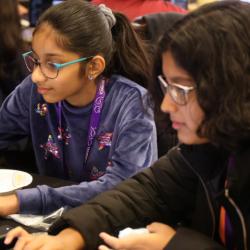Scientists Find First Evidence of Gravitational Waves at Extremely Low Frequencies
UMD astronomer Elizabeth Ferrara was part of a 15-year collaboration that used radio telescopes to tune into the hum of the cosmos.

Scientists using large radio telescopes to observe rapidly rotating stars called pulsars have found the first evidence of gravitational waves at extremely low frequencies, according to a set of papers published June 28, 2023, in The Astrophysical Journal Letters. Their discoveries could help scientists unlock the secrets of gravity and its effect on the cosmos.
The papers are the culmination of 15 years of data acquired by the North American Nanohertz Observatory for Gravitational Waves (NANOGrav) Physics Frontiers Center (PFC), a collaboration of more than 190 scientists that includes Elizabeth Ferrara, an associate research scientist in the University of Maryland’s Department of Astronomy.
Ferrara, who is also a NASA research scientist, explained that researchers are using pulsars—the ultra-dense cores of exploded stars—to study black holes and other facets of the universe.
“We’re beginning to peer deeper into how gravity has shaped the universe—to see how the most massive black holes have influenced the galaxies we see today,” Ferrara said. “With more observations, we will likely discover fundamental facts about our universe that cannot be explored using light alone.”
Cosmic clocks
While earlier results from NANOGrav uncovered an enigmatic timing signal common to all the pulsars observed, the signal was too faint to reveal its origin. Data collected over the last 15 years demonstrated that the signal is consistent with slowly undulating gravitational waves passing through our galaxy.
In 2016, the Laser Interferometer Gravitational-wave Observatory (LIGO) became the first experiment to directly detect gravitational waves. However, these newly discovered waves could only be perceived by a detector much larger than Earth.
To that end, astronomers turned a section of the Milky Way into a huge gravitational-wave antenna by using pulsars to create a pulsar timing array—a detector that’s co-managed by the Parkes Pulsar Timing Array in Australia, the Chinese Pulsar Timing Array, the European Pulsar Timing Array and the Indian Pulsar Timing Array.
Pulsars spin rapidly, sweeping beams of radio waves through space and making them appear to pulse when seen from Earth. The fastest of these objects, called millisecond pulsars, spin hundreds of times each second. Pulsars are dependable “cosmic clocks” because their spin is extremely fast and stable, but the timing of their pulses can be affected by gravitational waves.
Ferrara played a key role in expanding the number of pulsars observed by NANOGrav to 68, enabling scientists to log thousands of hours of observations and improve their odds of finding gravitational waves.
“The more pulsars we time, the more sensitive we are to gravitational waves,” Ferrara explained. “After some significant instrumentation upgrades in 2010 and 2012, I scoured the lists of known millisecond pulsars to find those with properties that support our precise timing measurements.”
Behemoth black holes
Einstein’s theory of general relativity predicts precisely how gravitational waves should affect pulsar signals. By stretching and squeezing the fabric of space, gravitational waves affect the timing of each pulse in a small but predictable way, delaying some while advancing others. These shifts are correlated for all pairs of pulsars in a way that depends on how far apart the two stars appear in the sky.
NANOGrav scientists believe their findings back this correlation theory. In addition, they think gravitational waves could arise from orbiting pairs of black holes that are billions of times more massive than the sun.
Future studies of this signal could provide insight into titanic black holes merging in the hearts of distant galaxies. Ferrara said they should be able to draw more conclusions by adding more pulsars to their detector, with help from other research teams in Australia, Europe and India.
“The next step is to grow our detector even more,” Ferrara said. “That may allow us to uncover what kinds of objects are generating these waves, whether they’re from incredibly large black holes circling each other, remnants of the early rapid expansion of the universe or even something completely unexpected.”
###
Their set of five papers, titled “The NANOGrav 15-year Data Set,” was published in The Astrophysical Journal Letters on June 28, 2023.
This work was supported by the National Science Foundation Physics Frontiers Center (Award Nos. 1430284 and 2020265), the Gordon and Betty Moore Foundation, NSF AccelNet (Award No. 2114721), the Natural Sciences and Engineering Research Council of Canada and the Canadian Institute for Advanced Research. This article does not necessarily reflect the views of these organizations.
This article is adapted from text provided by NANOGrav.







